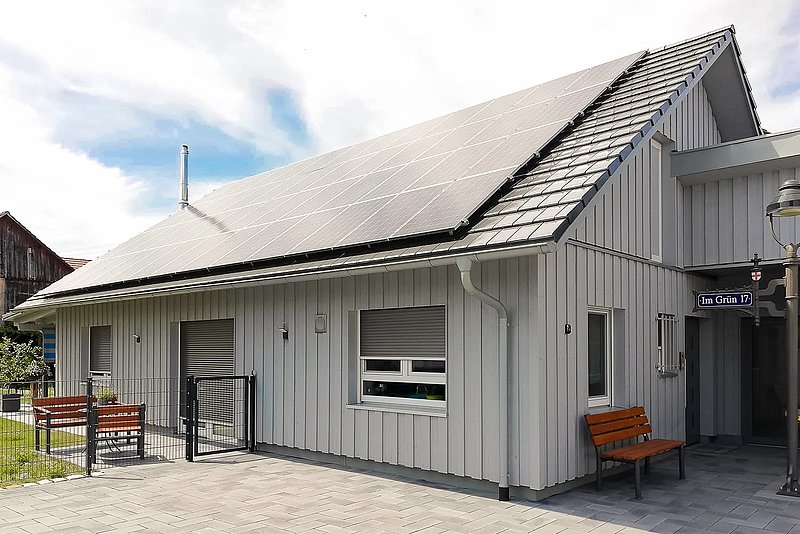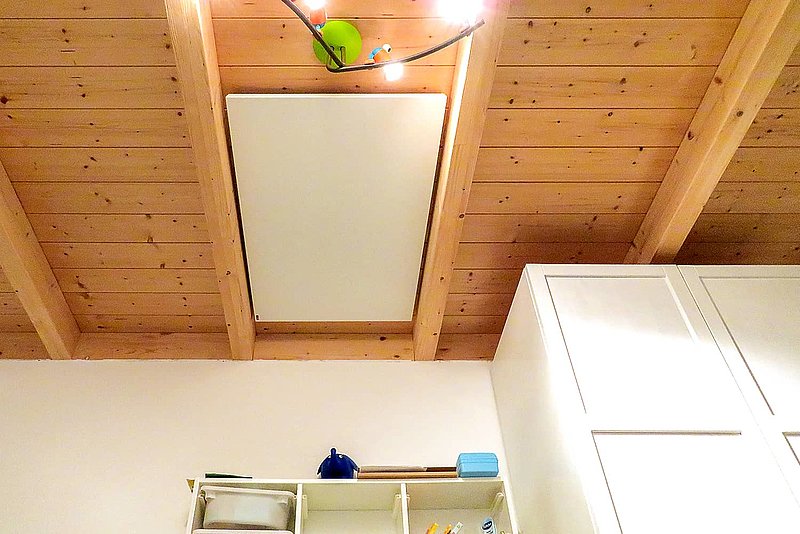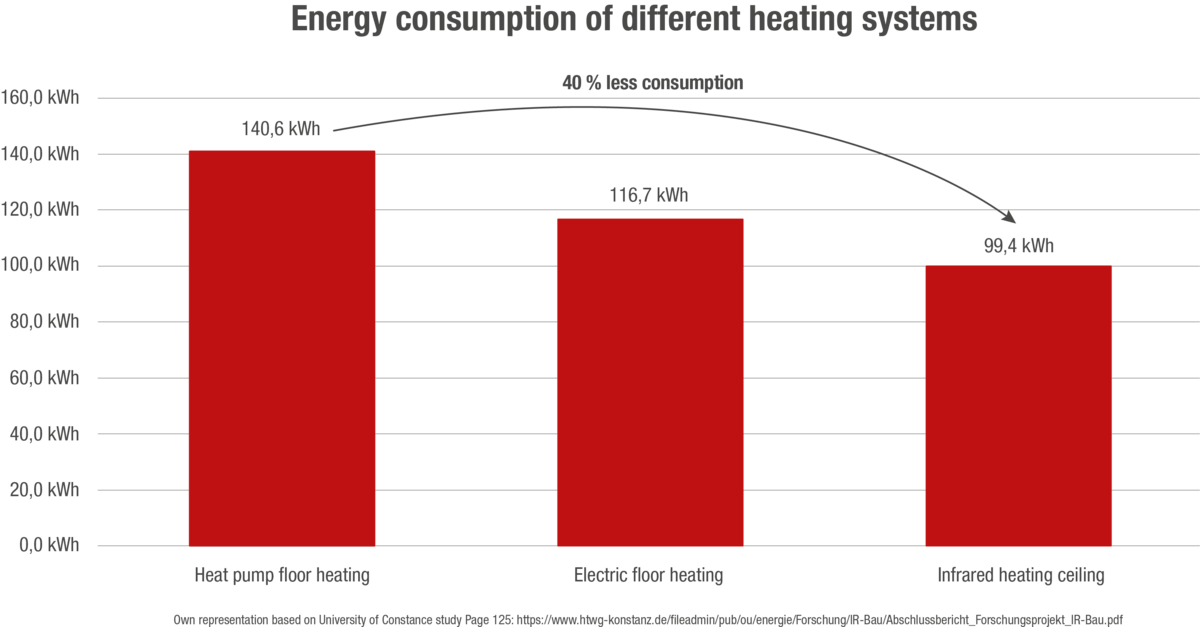Due to the very low heating requirement resulting from the specifications of the KfW "efficiency house" standards (KfW 40, KfW 55, KfW 70), a new building can be optimally heated with a decentralised infrared heater with minimal installation effort compared to conventional central heating systems. For example, the heating requirement for a KfW 40 house is < 25 kWh per m² per year. For a heated living space of 150 m², this corresponds to only 3,750 kWh per year.
Since infrared heaters with a high proportion of radiation are subjectively perceived as warmer than conventional heating systems due to the radiant heat and infrared heaters can react much faster to external heat sources such as solar radiation compared to underfloor heating, the actual consumption can be even lower. This is proven by our references in actual operations.
Reheating effects are a major disadvantage of underfloor heating systems, which are standard in new buildings. Infrared heaters solve this problem with their extremely fast response time, which prevents unnecessary overheating of the rooms.
Since new buildings are usually equipped with large window fronts facing south, solar radiant heat can be optimally harnessed to heat the house in combination with an infrared heater.
In a detailed study, the University of Constance compared the real consumption of underfloor heating systems using a heat pump and, alternatively, electric underfloor heating and infrared heaters in a well-insulated building.
Despite the coefficient of performance of the heat pump (proportion of heat that it can extract from the ambient air with one kWh of electricity -> measure of the efficiency of heat pumps), an infrared heater is more attractive in the long term when factoring in total costs and ecological aspects. This assumes that the savings from the purchase of an expensive heat pump system are invested directly in a photovoltaic system.
The small difference in actual consumption is mainly due to the fact that the heat pump, by way of the underfloor heating, consumes over 40% more energy than an infrared heater because of the slow response time and the associated overheating of rooms (source: University of Constance, Abschlussbericht Forschungsprojekt IR-Bau, page 125). This reduces the theoretical advantage of the purely laboratory-defined coefficient of performance (COP) to a large extent.
In addition, infrared heating systems have at least 50% lower transition losses compared to water-guided underfloor heating systems installed in the heating screed. (Source: University of Constance, Abschlussbericht Forschungsprojekt IR-Baut, page 193)
Based on our many years of experience with infrared heaters in new buildings, we could not find any significant differences in consumption between heating with infrared heaters and comparable houses with air heat pump systems. In some properties, a heat pump system may save €200-300 in consumption costs during a mild winter. If, for example, a new building with an infrared heater requires approx. €700 in heating costs per year, the significantly more expensive and more complex heat pump system may be able to heat the house for only approx. €500 per year.
However, if a very cold winter should occur, the heat pump would have to rely on the enormously expensive heating rod operation during this time when temperatures are very low. This eliminates the advantage of the heat pump, since heating is then provided with the most expensive type of heating of all, i.e. direct electric heating via heating rods. This is combined in turn with all the disadvantages of the central heating system (line losses, overheating due to the slow response time of underfloor heating, pump power consumption, etc.).
Assuming that the heat pump system has a small advantage in terms of pure consumption, e.g. approx. €200 per year, in most cases this advantage is cancelled out by the maintenance and servicing costs associated with the heat pump. Many manufacturers require a direct maintenance contract to maintain the warranty and service life, otherwise there is a risk of high financial repair costs in the event of a premature defect.
Even if heat pump systems are properly maintained, they have a significantly shorter life expectancy than a high-quality infrared heating system simply because of their enormously higher complexity. Experience shows that heat pumps require major reinvestment after 15-20 years (compressor replacement, etc.). This can quickly cost thousands of euros and is unfortunately often insufficiently factored into overall cost considerations.
In a nutshell: A heat pump system, in reality, hardly consumes less than an infrared heater, provided that it is an infrared heater with a high proportion of radiation. Possible savings are usually offset by maintenance costs. This means that the running costs are roughly the same, with the big difference that a heat pump heating system with underfloor heating is significantly more expensive to purchase (approx. €10,000-15,000 depending on the system) than a high-quality infrared heater.
An infrared heater from HALLER consists exclusively of high-quality components with a very long service life, which can significantly exceed that of a heat pump system, resulting in lower reinvestment costs in the long term.
The savings in the purchase of the infrared heater can be invested directly in a large photovoltaic system. €15,000 can buy a photovoltaic system of approx. 10 kWp, which produces approx. 10,000 kWh (depending on the roof orientation) of green energy per year.
If we now compare the two systems at the same initial cost, an infrared heater in combination with a photovoltaic system is significantly better, both economically and ecologically, than a conventional heat pump heating system. (Source: University of Constance, Abschlussbericht Forschungsprojekt IR-Baut, pages 12-13)
If you also invest in a power storage system, you can largely supply yourself with electricity, depending on your consumption habits. For example, with an annual production of 10,000 kWh of photovoltaic electricity and an annual electricity consumption of 10,000 kWh, 100% of the electricity consumption can be covered by the electricity cloud solutions of our SENEC storage units.




